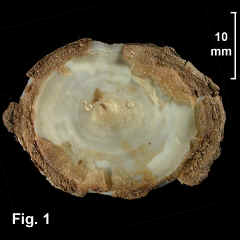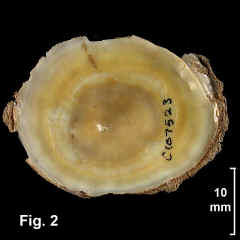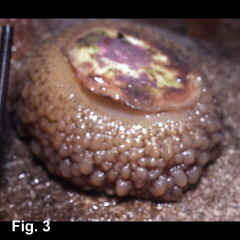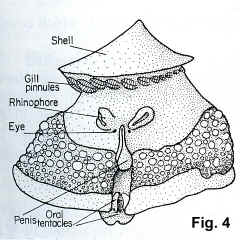|
|
UMBRACULIDAE |
|
|
|
Umbraculum umbraculum ([Lightfoot], 1786) Description: Shell light or moderate in weight, limpet-shaped, nearly flat or moderately elevated, apex approximately central. Shell white, grey or fawn, with irregular concentric growth lines; and sometimes with broad, low radial ribs. Interior brown centrally with circular muscle scan. Exterior with thick hairy periostracum which readily cracks and falls off dried shells. Size: Shell up to 100 mm in maximum dimension. Distribution: Supposedly circum-global in tropical and temperate seas. Across northern Australia, and on the east coast, as far south as Tasmania. Habitat: Lives on exposed rocky shores from the low intertidal down to around 100 m. It lives and feeds on sponges, as described by Willan (1984). Comparison: The shells of this species reach up to 100 mm diameter, compared to 40 mm for Tylodina corticalis. Small shells are difficult to assign to either species; those of U. umbraculum sometimes have broad radial ribs, while those of T. corticalis are smoother. The periostracum of T. corticalis has strong, raised axial ribs, absent in U. umbraculum, where the periostracum is hairy. Synonymy: Some other names used for this species in Australian literature are Umbraculum sinicum (Gmelin, 1791), Umbraculum indicum (Lamarck, 1819) and Umbraculum botanicum Hedley, 1923. Remarks: The animal is globular with a pustulose surface, as shown in Fig. 4. Rudman, in The Sea Slug Forum, said "The body is circular, with large pustules. Even when crawling, the animal cannot elongate and the position of the head can only be determined by the tubular rhinophoral tentacles which extend out from beneath the shell. Below these tentacles the body is split by a "mid-anterior cleft" in which the permanently protruded penis sits and the mouth opens. Umbraculum umbraculum is a sponge feeder, and has been recorded on a number of different species of Demospongia. The proboscis does not evert, so in feeding, the anterior cleft must be spread open so that the mouth can be pressed against the sponge colony". Good photos of the animal are on the Sea Slug Forum at http://www.seaslugforum.net/find/umbrumbr . Figs. 1, 2: Windang, NSW (C.107523). Fig. 3: Live animal (Photo Geoff Avern, Australian Museum). Fig. 4: Diagrammatic view of animal (Fig.1(d) from Thompson (1970)).
|
|



